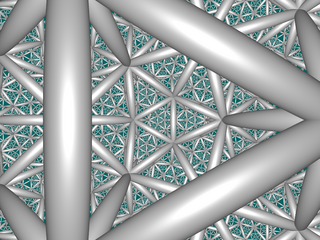| Icosahedral honeycomb | |
|---|---|
 Poincaré disk model | |
| Type | Hyperbolic regular honeycomb Uniform hyperbolic honeycomb |
| Schläfli symbol | {3,5,3} |
| Coxeter diagram | |
| Cells | {5,3} (regular icosahedron) |
| Faces | {3} (triangle) |
| Edge figure | {3} (triangle) |
| Vertex figure |  dodecahedron |
| Dual | Self-dual |
| Coxeter group | J3, [3,5,3] |
| Properties | Regular |
In geometry, the icosahedral honeycomb is one of four compact, regular, space-filling tessellations (or honeycombs) in hyperbolic 3-space. With Schläfli symbol {3,5,3}, there are three icosahedra around each edge, and 12 icosahedra around each vertex, in a regular dodecahedral vertex figure.
A geometric honeycomb is a space-filling of polyhedral or higher-dimensional cells, so that there are no gaps. It is an example of the more general mathematical tiling or tessellation in any number of dimensions.
Honeycombs are usually constructed in ordinary Euclidean ("flat") space, like the convex uniform honeycombs. They may also be constructed in non-Euclidean spaces, such as hyperbolic uniform honeycombs. Any finite uniform polytope can be projected to its circumsphere to form a uniform honeycomb in spherical space.